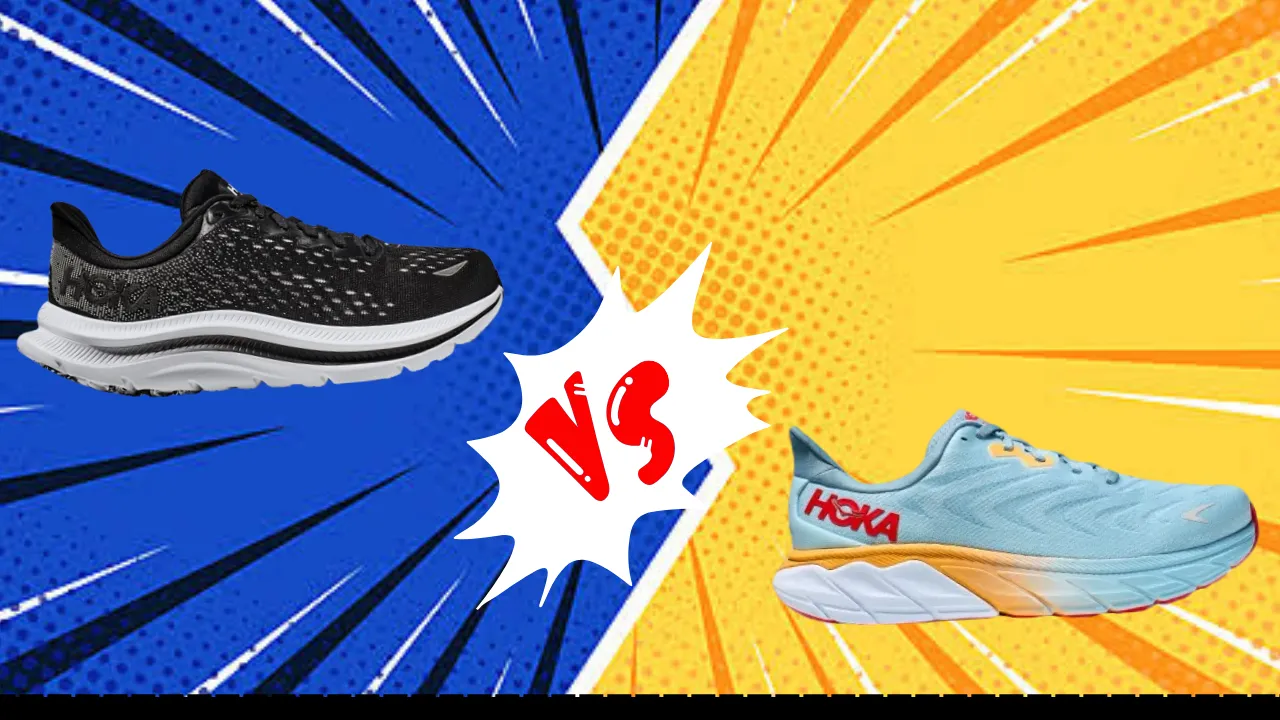Finding the right running shoe can make all the difference in your performance and comfort on the road or trail. Two popular stability shoe options from Hoka One One are the Kawana and the Arahi 6. Both offer cushioning and support, but they have key differences that may make one better suited for your running needs.
This in-depth comparison of the Hoka Kawana versus Arahi 6 reviews all the nitty-gritty details including materials, stability, cushioning, and real-world performance for running, walking, plantar fasciitis, and all-day wear. Read on to determine which Hoka shoe is the better choice for you.
Similarities And Differences Between Hoka Kawana and Hoka Arahi 6:
| Feature | Hoka Kawana | Hoka Arahi 6 |
|---|---|---|
| Launched In | 2022 | 2022 |
| Stability | Neutral | Mild to Moderate |
| Flexibility | Moderate | Moderate |
| Sizing | Men’s 7-15, Women’s 5-12 | Men’s 7-15, Women’s 5-12 |
| Weight | 9.8 oz (M), 8.6 oz (W) | 9.6 oz (M), 8.8 oz (W) |
| Cushion | EVA foam, rockered geometry | EVA foam, J-Frame technology |
| Outsole | Durabrasion rubber | Durabrasion rubber |
| Midsole | Rockered geometry | J-Frame, rockered |
| Upper | Engineered mesh | Engineered mesh |
| Retail Price | $140 | $140 |
Features Comparison
Materials
The Kawana uses a Durabrasion rubber outsole while the Arahi 6 uses the same Durabrasion rubber compound. Both shoes have engineered mesh uppers for breathability.


The key difference lies in the midsole. The Kawana utilizes EVA foam and a rockered geometry while the Arahi 6 uses EVA foam combined with Hoka’s J-Frame technology for stability and a rockered profile.
Durability
The Durabrasion rubber outsoles on both the Kawana and Arahi 6 ensure these shoes can stand up to miles of wear and tear. Reviewers note that both models are durable for the long haul.
The Arahi 6 does have more stability features, which tend to break down faster than neutral materials. But overall, both offer comparable durability.
Fit
The engineered mesh upper on each shoe provides a comfortable and breathable fit. Both shoes also feature a roomy toe box. Sizing is consistent across both models.


The Arahi 6 offers a tighter midfoot wrap thanks to its structured overlay system. So runners needing a more secure fit may prefer the Arahi 6 over the neutral Kawana.
Stability
The Kawana is a neutral shoe while the Arahi 6 provides mild to moderate stability for overpronation. The Arahi 6 uses Hoka’s J-Frame technology in the midsole to prevent excess inward rolling of the foot without being too rigid or uncomfortable. So runners needing pronation control can rely on the Arahi 6 more than the neutral Kawana.
Cushioning
Maximal, pillowy cushioning is characteristic of most Hoka shoes. The Kawana and Arahi 6 deliver on the plush cushioning using EVA foam in the midsole.
The rockered profile of both shoes enhances softness underfoot while promoting an easier heel-to-toe transition. Cushioning is comparable between the two models. Those seeking a softer feel may find it in the Kawana over the stability-enhanced Arahi 6.
Value
With a $140 price tag, the Kawana and Arahi 6 are now equal in terms of pricing. So you don’t have to pay more for the additional stability features of the Arahi 6. This makes both shoes deliver excellent value given their comfort, cushioning, and longevity.
For neutral runners, the Kawana provides great cushioning and responsiveness at an affordable $140 price point. For overpronators needing support, the Arahi 6 is an equally well-priced option at $140 that won’t break the bank.
Its motion control makes it the better value pick if you specifically need help with excess inward foot rolling. But budget-conscious runners of any gait type get impressive quality and performance for just $140 in either shoe.
Performance Comparison
Walking
The ample cushioning and supportive innings of the Kawana and Arahi 6 make both great options for walking. The smooth rockered sole encourages a natural stride to keep you comfortable mile after mile.
The Arahi 6’s stability may provide slightly more support and motion control for some overpronators. But the Kawana’s neutral cushioning also adapts well to a walker’s gait cycle. Overall, both perform admirably as walking shoes.
Running
As neutral and stable running shoes respectively, the Kawana and Arahi 6 match up well with their intended running uses. The Arahi 6 effectively controls excess pronation during the running gait cycle while still feeling smooth and natural underfoot.
The Kawana offers a responsive, well-cushioned ride but without the pronation-fighting features. So for neutral gaits, the Kawana excels while overpronators are better served by the Arahi 6.
Plantar Fasciitis
The soft yet supportive cushioning in both the Kawana and Arahi 6 can relieve common plantar fasciitis symptoms like heel pain and arch stiffness.
However, the Arahi 6’s stability enhancements specifically target overpronation, often exacerbating plantar fasciitis. Its motion control and arch support make it the better choice for plantar fasciitis relief compared to the neutral Kawana.
All Day Standing
Cushioning that maintains comfort hour after hour is a must-have for all-day standing shoes. The Kawana and Arahi 6 both supply ample plush underfoot padding suitable for extended wear.
And their breathable uppers keep feet cool and dry even on long shifts. The Arahi 6 provides a touch more support which may help combat fatigue. But both models work well for standing all day thanks to their combination of cushioning and comfort.
final Verdict
For neutral runners or walkers seeking a cushioned yet responsive feel, the Hoka Kawana gets the edge. But runners with mild to moderate overpronation are better served by the Hoka Arahi 6 and its stability-enhancing features that provide support without sacrificing comfort.
Both shoes use quality materials and impressive cushioning systems to offer all-day comfort at an affordable $140 price point. The Arahi 6 is the ideal pick if you specifically need pronation control. But neutral runners get an equally impressive experience in the cushioned and smooth Kawana.
So consider your individual gait, use case, and preferences to decide if the Kawana or Arahi 6 is the best match to keep you comfortable and supported wherever your active lifestyle takes you.

